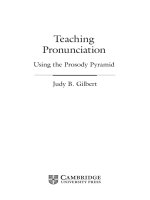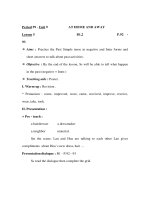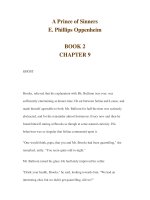Module 2:TEACHING PRONUNCIATION potx
Bạn đang xem bản rút gọn của tài liệu. Xem và tải ngay bản đầy đủ của tài liệu tại đây (2.97 MB, 40 trang )
TEACHING LANGUAGE
TO YOUNG LEARNERS
Language:
Pronunciation
Vocabulary
Grammar
General Principle
sounds words structures
TEACHING PRONUNCIATION
The scope of pronunciation
•
Individual sounds
•
Sounds in connected speech
•
Stress and rhythm
•
Intonation
Individual
sounds
Sounds in connected speech
Coffee, coffee
Milk and sugar, milk and sugar
Strawberries and cream, strawberries and cream
Chocolate cake and chocolate biscuits
Fish and chips
Fish and chips
Soup
S-O-O-O-U-P
Stress and Rhythm
COffee, COffee
MILK and SUGAR, MILK and SUGAR
STRAWberries and CREAM, STRAWberries and CREAM
CHOcolate CAKE and CHOcolate BIScuits
FISH and CHIPS
FISH and CHIPS
SOUP
S-O-O-O-U-P
More Practice
One two three four
One and two and three and four
One and a two and a three and a four
One and then a two and then a three and then a four
More Practice
One two three four
One and two and three and four
One and a two and a three and a four
One and then a two and then a three and then a four
Intonation
•
My name’s Peter.
•
Where’s my bag?
•
Can I open the window?
•
Stick it on here
•
What a beautiful shirt!
•
Would you like a lift?
•
Which shirt do you like, the red one or the blue one?
•
What there is left we’ll put it in the pot.
Techniques and Activities
Game Purpose
Stress Snap
Stress Domino
To practise recognizing the word stress
within 2 syllable words
Sound Bingo To practise recognizing similarities and
differences between sounds /
discriminating sounds
Happy Sound
Families
To practise recognizing similarities and
differences between sounds /
discriminating sounds
Odd one out To practise recognizing similarities and
differences between sounds /
discriminating sounds
… …
TEACHING VOCABULARY
What is vocabulary?
Lexical sets
e.g. shop, fruit, room in a house
Rhyming sets
e.g. bat, rat, hat, mat
Color sets
e.g. things that are green
Grammatical sets
e.g. adjectives, verbs, nouns, prepositions
Partners / collocations
e.g. play the piano, ride a bike, easy class, loud noise
Opposites or male and female
e.g. hot / cold, boy/girl
Background
Children are active learners in different
social contexts.
Other people help them learn by:
bringing objects,
talking while playing with them,
reading stories,
asking questions …
Children learn new words by interacting
with others
The vocabulary teaching and
learning process
5 main stages guided by teachers:
1.Understanding and learning the meaning of
new words
2.Attending to forms
3.Practising, memorizing, and checking
activities
4.Consolidating, recycling, extending, and
personalizing
5.Developing strategies for vocabulary learning
Stage 1
1. Understanding and learning the meaning
of new words
using objects
using drawings
using illustrations, pictures, photos,
flashcards
using actions, mime, expressions, gestures
pointing, touching, tasting, feeling, smelling
using technology
Stage 1 (continued)
1. Understanding and learning the meaning
of new words – verbal techniques
explaining
defining the context
eliciting
describing
translating
Stage 2
2. Attending to forms
listening and repeating
listening for specific phonological
information (individual sounds, number of
syllables, stress patterns)
observing the written forms (shape, letters,
spelling)
noticing grammatical information
copying and organizing
Stage 3
3. Practising, memorizing, and checking
activities
classifying / sorting
giving instructions
picture dictation
wordsearches
…
Stage 4
4. Consolidating, recycling, extending,
and personalizing
vocabulary book
collages
word networks/webs/trees
word boxes, banks, envelopes, boxes
…
Stage 5
5. Developing strategies for vocabulary
learning
Becoming aware of a variety of clues to help
guess and predict meaning
Planning and organizing a vocabulary record
keeping system
Do self-testing
Reviewing
…
TEACHING GRAMMAR
Attention
•
Formal teaching of grammar is not usually a
major objective in the young learners
classroom
•
Using form-focus techniques in
meaningful and interesting contexts
What grammar to teach?
notice the pattern, and then generate new language
expose, develop deep understanding of the
relationship between and grammar meaning
learn by heart
TYPES
1.Facts
2.Patterns
3.Choice
EXAMPLES
a.foot – feet,
b.My favorite color is blue.
c.leaf – leaves
d.I’ve played tennis since I was eight./
I’ve been playing tennis since I was
eight.
e.Pete is in the class.









